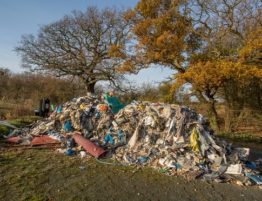
- Massive amounts of plastic accumulating in landfills and the ocean are harmful to marine life and costly to deal with.
- Policymakers, like those in the European Union, are looking at ways to slash plastic usage.
- Corporations, both large and small, are also turning to more environmentally friendly measures due to consumer demand.
Not enough is known about the long-term effects of plastics pollution, but what we do know looks bad.
For starters, there is an immense amount of it. Some 322 million tons of plastic, which amounted to more than 900 Empire State Buildings in mass, was produced in 2015, according to the United Nations Environment Programme.
Last year, a study published in scientific journal Science Advances estimated that the modern world had produced around 8.3 billion metric tons of virgin — newly manufactured — plastic. By 2015, 6.3 billion metric tons of that had become plastic waste, but just 9 percent had been recycled, the researchers found.
Plenty of plastic also ends up in the ocean, where it harms marine biodiversity and can fragment into minuscule particles, or microplastic, that is ingested by animals and, indirectly, humans — although evidence is inconclusive about how harmful that is for us.
Many of the problems encountered with the material stem from the fact that the most popular plastics used today aren’t biodegradable: The material doesn’t decompose, and instead accumulates both on land and in the ocean.
And that build up in plastic looks set to worsen if no additional action is taken. The amount of plastic accumulating in the ocean is expected to triple between 2015 and 2025, according to a report by the U.K. Government Office for Science.
It’s both an environmental and an economic problem: The United Nations Environment Programme found that marine litter costs a minimum of $8 billion annually in damage to marine ecosystems.
Tackling plastic waste
Governments are among the institutions looking for measures to alleviate the situation, with the European Union adopting a bloc-wide strategy to tackle plastics in January this year.
Part of the measures in the strategy include reducing plastic bag usage, as well as investments into the technology and materials spaces. The EU pledged an additional 100 million euro to encourage the development of more recyclable plastics materials and to make recycling more efficient.
Corporations are also paying attention as consumer demand for environmentally friendly products grows. Tech giant Dell last year launched a pilot program to recycle ocean plastics to make packaging trays for laptops.
Others, like consumer goods conglomerate Unilever and food and drink giant Nestle, have pledged to move toward 100 percent recyclable plastic packaging.
Smaller start-ups have also attempted to make a difference. Berlin-based food delivery company Foodpanda began giving users in Asia Pacific the option of requesting for disposable cutlery this year amid growing concern that the popularity of food delivery services was generating greater levels of waste due to the increased use of disposable packaging.
In Singapore, where the measure was rolled out among Foodpanda’s top 20 vendors in January, 10 percent of orders have opted out of receiving disposable cutlery with their food. The start-up expects to save a million sets of cutlery by the end of the year, said Laura Kantor, Foodpanda’s head of marketing and sustainability lead.
Apart from that, Kantor told CNBC the start-up was looking into both cutting its overall use of packaging and replacing packaging with more sustainable materials.
Bioplastics
The demand for alternative materials by businesses looking to adapt to consumer preferences for going green is, in turn, giving a boost to the bioplastics industry. Various market research estimates expect the sector to reach anywhere from $35 billion and $65.6 billion by 2022.
That’s good news for Singapore-based bioplastic manufacturer Olive Green, which produces various biodegradable disposable tableware and packaging products from a corn-based bioplastic it develops. The niche sector is much smaller compared to the traditional plastics markets and market acceptance for alternatives can make the industry tough, said Olive Green Chief Executive Aloysius Cheong.
For comparison, total bioplastics capacity today stands at 4.2 million tons, according to market research firm PCI Wood Mackenzie. That compared to the 302 million tons in total demand for the top five polymers last year.
Still, Cheong said he was positive on the outlook of the sector. He pointed to government action taken in recent years as a source of optimism, citing a ban on disposable plastic bags in parts of India as a sign of building momentum.
For now, there are several challenges that bioplastics continue to face, including economies of scale for production and cost-related hurdles, analysts from PCI Wood Mackenzie told CNBC.
If those issues can be solved, “in the long term, we could see a material impact,” PCI Wood Mackenzie said. “Should anything become more cost effective, it will likely be implemented,” the analysts said, adding that legislation or taxation changes could be helpful for the bioplastic space — but they’ve generally been slow.
“Provided the challenges facing biomass today are overcome, biomass can become a larger portion of the supply. Biochemicals and bioplastics could then erode a portion of oil demand, much like recycling can erode overall virgin plastics demand,” according to PCI Wood Mackenzie.


